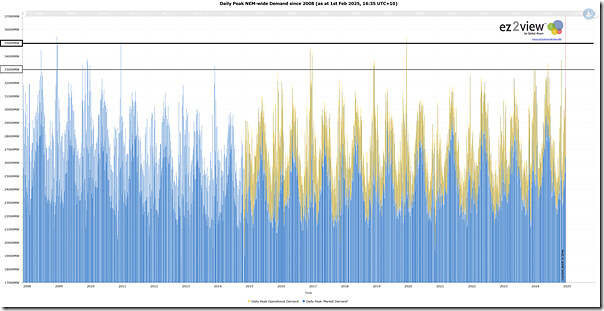With respect to forecasts for peak NEM-wide ‘Market Demand’ in summer 2024-25 (and particularly following Friday’s article noting ‘Forecasts ‘hotting up’, for NEMwide demand on Monday 3rd February 2025’) we fielded a few questions about how extreme that might be.
So we thought we’d provide this article as some context.
Should NEM-wide ‘Market Demand’ surpass 33,000MW the headline could be:
- Certainly not highest ever, in a historical sense
- But well worth noting, given how rare an occasion it is.
(A) A brief reminder about the complexity of measuring ‘Demand’ …
…. because it’s not as simple as some might initially think.
We’ve later pulled out this reminder as the separate article ‘A brief reminder about the complexity of measuring ‘Demand’ …’ here.
With this in mind, let’s look on….
(B) A long-range trend of daily peak
So utilising the ‘Trends Engine’ within ez2view we’ve put the following trend together, showing both ‘Market Demand’ and ‘Operational Demand’ (noting that reconstructing an estimate of ‘Underlying Demand’ over such a long time range is more complex and we don’t have time to do this today for this brief article.
Remember to click on the image for a larger-resolution view.
For ease of reference, I’ve added a horizontal line:
- at 35,000MW (only 4 days have ever seen higher) and
- at 33,000MW (only 32 days have ever seen higher … in 6,241 days (so 0.5% incidence))
(C) A tabular listing of some of those high demand days
With the above chart as a reference, here’s some of the high points in each year noted (with some linked to articles written at the time).
| Year | Brief Explanation of the peak for the year,
in terms of ‘Market Demand’ |
|---|---|
|
2008 |
1 day over 33,000MW … this
|
|
2009 |
2 day over 35,000MW … which were:
Another 8 days (10 in total) over 33,000MW. |
|
2010 |
5 days over 33,000MW |
|
2011 |
5 days in a row over 33,000MW – including in the middle one day over 35,000MW:
|
|
2012 |
0 days over 33,000MW |
|
2013 |
0 days over 33,000MW |
|
2014 |
1 days over 33,000MW …
|
|
2015 |
0 days over 33,000MW |
|
2016 |
0 days over 33,000MW |
|
2017 |
2 days over 33,000MW … which were:
|
|
2018 |
0 days over 33,000MW |
|
2019 |
5 days over 33,000MW in January 2019:
… and nothing for the rest of the year |
|
2020 |
January 2020 saw both:
|
|
2021 |
0 days over 33,000MW |
|
2022 |
0 days over 33,000MW |
|
2023 |
0 days over 33,000MW |
|
2024 |
Monday 16th December 2024 reached 33,674MW. |
|
2025 ytd |
This year is only very young … only 1 month old. The highest daily peak so far this year has been 31,528MW on Monday 27th January 2025. If Monday 3rd February 2025 exceeds 33,000MW it would be the first day in the year |
So let’s wait to see what unfolds…



Leave a comment